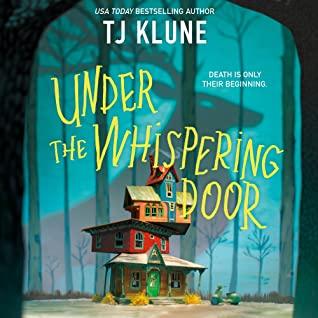I loved The House in the Cerulean Sea, so I was happy to get an advanced review copy of his newest book, Under the Whispering Door. The covers appear to be by the same artist, so I’ve seen a number of people asking if this is a sequel, but it is not. Readers will disagree over whether this book is like Cerulean Sea and my answer is, in some ways yes and in some ways no.
Yes, in that it deals with common themes around love and humanity, being yourself, accepting others and finding that place where you feel at home.
No, in that there aren’t any heartwarming children, and this book is quite a bit darker (if you can say a book featuring the Antichrist as a main character is “light”). Klune’s focus here is on death itself, what it means to live a good life before it’s too late, and what we leave behind. A number of the storylines in this book are tragic and disturbing, particularly the terminal illness of a young girl that leaves her mother unable to move on.
Klune has reimagined the concept of what happens when we die. Instead of heaven or hell or purgatory, the dead are escorted by a Reaper to a little tea shop in the middle of nowhere. At the top of the house, there’s a door. Hugo (who calls himself “the ferryman”) is responsible for helping the dead go through that door, to whatever awaits them. Although the door calls, or “whispers”, to the newly dead, they get to take their time if they need it. Until then, there’s tea (hand-grown and personally selected by Hugo) and there’s companionship. And therapy, of a sort.
The book begins with a lawyer named Wallace, who is over-the-top selfish. After he has a sudden heart attack, no one mourns his death – not his partners, his employees, or his ex-wife. At his own funeral he meets Mei, his Reaper. It’s her job to bring Wallace to the tea shop and acclimate him on what it means to be dead. He doesn’t make it easy.
I love the idea that the dead get a little time to understand death, before accepting the next steps in their journey. (I also liked the idea that there’s a perfect tea for all of us.) Though as I was reading was, I wondered why, if it’s likely that our loved ones who are deceased are waiting for us on the other side, why are people so hesitant to go through the door? Maybe because it means accepting one’s mortality, or because we feel closer to the living than the dead.
If you loved Cerulean Sea, you’ll be happy to know that much of what worked so well in that book, also works here. Klune takes stereotypical, almost cartoonish characters and instead of making fun of them, you come to love them instead. It’s heartwarming without being cloying or sappy. Somehow he’s able to maintain a balance of humor, clever dialogue, and deeply-felt emotion. So even if you know what’s coming, you’re still happy to see these characters grow and develop in a positive direction.
Klune doesn’t really do subtle, so you shouldn’t expect that in this book. I did appreciate the transition Wallace goes through, especially when he’s forced to confront his own bad behavior in the form of the next dead traveler.
Where Klune excels is in keeping his characters from being too perfect, or too villainous. There are no Snidely Whiplashes here, even though some characters are pretty horrible, like the charlatan Desdemona and the dreaded Manager. There’s capacity for redemption for even the worst of us. I loved the variety and the complexity of the side characters Klune introduces, like Hugo’s grandfather; if this was just a story about Wallace and Hugo, it would have been pretty dull.
I don’t love the title of this book (why Under the Door rather than Through or Behind?) but that’s a small issue. I read the print version of this book, but my guess is the audiobook version is as wonderful as Cerulean Sea was, and very worth listening to (though with a different narrator). I can’t say I’d mind going back to this story a second time.
Note: I received a complimentary advance review copy from NetGalley and publisher Tor Books. This book was published on September 21, 2021.


